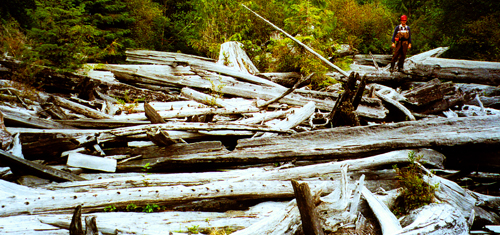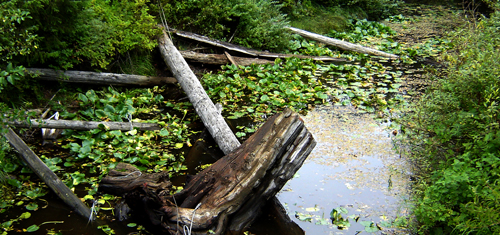Salmon stream restoration
Pacific Rim National Park Reserve
Kennedy Flats Watershed | Cheewaht Lake Watershed
Kennedy Flats Watershed

Unhealthy stream
© Central Westcoast Forest Society
The Kennedy Flats Watershed, adjacent to Pacific Rim National Park Reserve, is a unique, flat landscape which formed when glaciers receded 10,000 years ago. Gravel deposits in this landscape provided excellent spawning habitat for salmon, supporting a large “fish factory” that produced huge numbers of wild salmon. These numbers are now significantly reduced as a result of the destruction of their habitat.
Salmon streams on the decline
Increased demand for lumber fuelled large-scale industrial logging on the west coast between the 1950s and early 1990s. The low-lying landscape of the Kennedy Flats Watershed provided easy access to its old-growth forests. Historically, the environmental impacts of clearcut logging were not appreciated but these practices affected salmon habitat in two significant ways. Firstly, after clearcutting an area, scrap trees was placed into streams to create bridges which assisted with the movement of valued lumber. This activity made the streams impassable to salmon. Secondly, glacier-deposited spawning gravel was removed from the streams for use in logging-road construction. As a result, streams were significantly damaged and the numbers of salmon plummeted.
Restoring the streams

Healthy stream
© Central Westcoast Forest Society
According to the Society for Ecological Restoration International, ecological restoration is the “process of assisting the recovery of damaged ecosystems”. In Kennedy Flats, restoration work involves repairing the damage caused by industrial logging. Restoration crews have removed most of the woody debris and undesirable vegetation from both the streams and riparian (stream-side) areas. These efforts will help heal these streams so that wild salmon may return to the area.
A collaborative approach
Stream restoration work is a huge undertaking, requiring the cooperative efforts of various organizations. Under the leadership of the Central Westcoast Forest Society, restoration team members have come from First Nations, chambers of commerce, local governments, private industry, scientists, concerned citizens and Parks Canada. These stakeholders recognize the need to repair these streams for the health of the ecosystems and the local economy.
Future of salmon streams
Restoration work continues both inside and outside Pacific Rim National Park Reserve in the Kennedy Flats Watershed, with significant efforts concentrated on Lost Shoe, Staghorn, Kootowis and Sandhill Creeks. As these groups work towards a common goal, their hope is that vibrant streams full of salmon will flow again for future generations.
Cheewaht Lake Watershed

The Cheewaht Lake watershed lies within the traditional territory of the Ditidaht First Nation and is an area of cultural significance. Most of the northern and eastern watershed sections (except for the rim around the lakeshore) are public lands and are managed for timber production. The forest northeast and east of Cheewaht Lake extending to the Pacific Rim National Park Reserve boundary, was logged between 1984 and the mid-2000s. Logging activities and subsequent bank failure upslope from the national park reserve have degraded spawning and rearing salmon habitat in the national park reserve.
All known Cheewaht Lake spawning areas are within the Pacific Rim National Park Reserve boundary. The Cheewaht Lake watershed supports populations of sockeye (Oncorhynchus nerka), coho (O. kisutch) and chum salmon (O. keta), and steelhead (O. mykiss), sea-run and resident cutthroat trout (O. clarkii). Sockeye begin to enter Cheewaht Lake in February and spawning occurs in streams flowing into the lake from October until early December. Spawning has decreased in these streams as a result of upslope instability caused by logging and subsequent infilling of preferred holding and spawning areas.
Sockeye streams on the decline
The Cheewaht Lake sockeye salmon used to be the favourite fish for the Ditidaht First Nation due to is culinary properties, abundance and accessibility. Sockeye runs into the lake during pre-industrial times could reach 10,000 fish. More recent estimates have varied between 500 and a few thousand fish. This sockeye population was first heavily impacted by gill-netting at the mouth of Cheewaht River and from 1982 by spawning habitat degradation due to logging. There is a fear that some runs restricted to particular streams may go extinct if remedial action is not taken soon.

Sockeye stream restoration plan
From 2017-2019, Parks Canada consulted with the Ditidaht First Nation and other land managers and stakeholders in the region on a sockeye salmon stream restoration plan for the Cheewaht watershed, including the Department of Fisheries and Oceans, West Forest Products Inc., and British Columbia Timber Sales. In 2020, Pacific Rim National Park Reserve, in collaboration with the Ditidaht First Nation and contractors, began a process to restore the total of 1.1 km of salmon-bearing streams. This will improve fish-holding, spawning and fry rearing conditions for sockeye and coho salmon. In time, increased salmon runs will benefit the entire coastal ecosystem from coastal trees, to eagles and bears, to the traditional managers of the lands – the Ditidaht First Nation.
A Collaborative Approach
Parks Canada recognizes that restoration of the Cheewaht Lake Watershed will only be possible if the entire watershed both within and outside Pacific Rim National Park Reserve is managed collaboratively with a range of land managers, including the Ditidaht First Nation who have been present on these lands for millenia.
To pursue this important project, the Cheewaht Restoration Working Group was set up in 2017. The Working Group is focused on facilitating restoration of the namesake watershed to as near a natural state as possible before any development, such as sustainable forestry harvest, takes place. The Working Group includes a broad representation from all those with an interest in the stewardship of the area. Participants include:
- Ditidaht First Nation
- Nuu-chah-nulth Tribal Council/Uu-a-thluk
- Fisheries and Oceans Canada, including the Nitinaht Hatchery
- Parks Canada
- Ministry of Forests, Lands and Natural Resource Operations (South Island)
- British Columbia Timber Sales
- Western Forest Products
- Teal Jones
- MC Wright and Associates

Future of Cheewaht salmon streams

Related links
- Date modified :